What we do
Services
Experts in
Long gone are the times when people needed to check advertising columns to know what's going on in their hometown. These days we can browse all the info online or utilize a dedicated event application.
A local event app is a platform operating within the context of physical events happening in the selected area. It provides users with fast info updates, enables interaction, and boosts communication between all involved parties.
By building such an application, you can help people to discover fun activities and organize their leisure time while promoting event culture in your town or country. On top of that, the event industry is a huge market. With the right approach, you can turn your idea into a lucrative startup that can win hearts and pave the way to global acknowledgment.
Ready to start the journey? This guide will walk you through the stages of the app development process and provide you with some tips on how to build an outstanding local event aggregator. So here we go!
The first thing on the to-do list would be to grasp the fundamental pillars on which the event planning industry stands. Knowing what your prospective competitors do will help you to finalize your business strategy and set the direction to your market niche.
Best apps for local events you should know about:

Eventbrite is the world’s largest “events near me app”, where people can discover things to do, check out where their friends are going, get recommendations, and buy tickets or register for desired live happenings.
It is also a tailored tool for event organizers which they can use to create, promote, and manage their performances, concerts, lectures, conferences, etc. It has built-in payment processing, analytics, and support modules and also allows the reaching of a broader audience through social media integration.
Eventbrite is an avowed industry leader, yet it doesn't slip into complacency. The company constantly improves its services by adding more functions that can make clients' interactions with the platform more efficient.
Recently, Clockwise Software was contracted to develop an extension for Eventbrite — an auto-publishing tool. It enables organizers to set the exact time when the event should be published to the site, allowing them to focus on more important tasks.
Nowadays it's hard to find an urban dweller who doesn't use Facebook. This social media network was a huge event aggregator even before we entered the smartphone era. So it is definitely a place to check if you are looking for last-minute suggestions, planning a weekend, or an upcoming journey.
You can browse events directly through the site or download Facebook Local, a dedicated app for searching events near you, where you can follow your friends' check-ins and read reviews of local businesses.
DoStuff was first launched in Austin, TX in 2006 and since then it has grown into a vast network comprising more than 20 major cities in the U.S., Canada, and Mexico. The platform is curated by local influencers who list hand-picked events and craft comprehensive city guides. Users can browse the activities by category or check out the ‘what’s happening today’ feature.
YPlan, a London-based event app, was founded back in 2012. This platform enables users to discover and book inexpensive last-minute deals. In its early days, it was said that every third iPhone user in London had YPlan installed on their device. In 2016, the startup became a part of a global media and entertainment company called Time Out Group.
Even though it might seem hard to outdo such event industry giants, there are some tricks that can help you to build a remarkable social event app. Here are a few tips to consider if you are planning to develop Eventbrite's future rival:
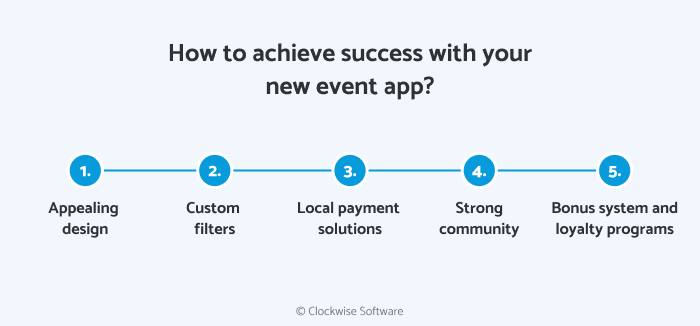
Appealing design
Create a user-friendly interface with a well-structured layout and various icons to make the navigation through the app easier.
Custom filters
Attendees are looking for an easy to navigate app to find local events which match their interests. Thus, all app content should be tagged and sorted out so users can discover the required info within the specified category.
Integrate local payment solutions
Event platforms operating worldwide tend to utilize global payment gateways, like PayPal or Braintree. Not all of such PSPs might be available in your country. Be ready to turn this deficiency to your advantage by providing users with local payment solutions.
Build the community
Sync your application with social media accounts and let your users invite their friends to join the platform. Another way to build a strong community is to enable in-app communication. This can include direct messaging, check-ins, recommendations, a “follow friends” option or “contact organizer” button — all those things that could make your product more interactive.
Introduce bonus systems and loyalty programs
Offer discounts and other incentives to active users. You can craft a multi-level bonus plan, organize lotteries, and launch contests to keep your clients engaged and thus increase your app's retention rate.
An event application brings together three parties: attendees, meeting organizers, and a platform operator. From this perspective, such apps can be seen as a type of marketplace. We have researched the topic of marketplaces and how to build them earlier.
The app facilitates the interaction between clients (event-goers) and service providers (planners) through the means developed by the platform operator. As each of the stakeholders pursues their objectives while using the app, its structure and functionality should cater to their specific needs:
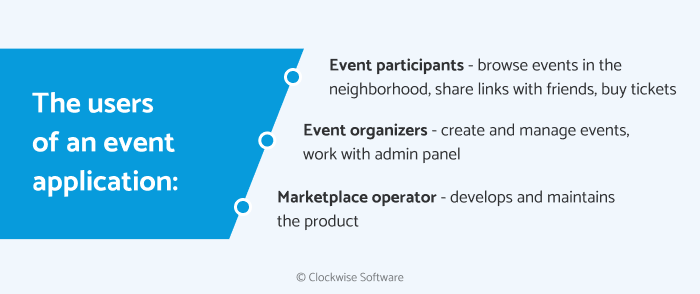
Knowing your target audience's requirements will help you to decide which modules to include in your final product and pave the way to creating the best app for events.
Don't let your users drown in the massive flow of information and waste their time by browsing through the lengthy list of different happenings. All events should be arranged by type: gigs, movies, theatre performances, parties, conferences, lectures, art exhibitions, etc. Moreover, you can add filters to further facilitate the quest within the chosen category. Let attendees browse events by artist/speaker, venue, date and time, and price.
Provide your clients with the ability to choose seats, buy tickets, and manage their bookings on the go. Offer them a safe way to pay for their purchase by integrating reliable payment gateways.
People do forget stuff. Sometimes it can also mean the events they've already secured the admission to. That's why it's a good idea to send them reminders some time in advance and also the very day of the gathering. An event tracking feature that helps attendees to keep updated might also be an option to jog their memory. You can also integrate your app with Google Calendar, which will automatically save the info about desired events to a user’s personal timetable.
Geolocation can help attendees set the optimal route to the venue and calculate the estimated time they will need to get there. To make sure they won't get lost at the spot, you can also include interactive floor plans. These features will be especially useful if the event takes place at a new site or one located off the main roads.
Local travel guides are also quite a useful thing to have. They will be highly appreciated by people who are visiting your area for the first time, but locals willing to explore their hometown could also find them entertaining. So at some point, you might add Yelp-like features with ratings and recommendations for best enterprises nearby or craft blog posts about local specialties, must-do lists, and other practical advice.
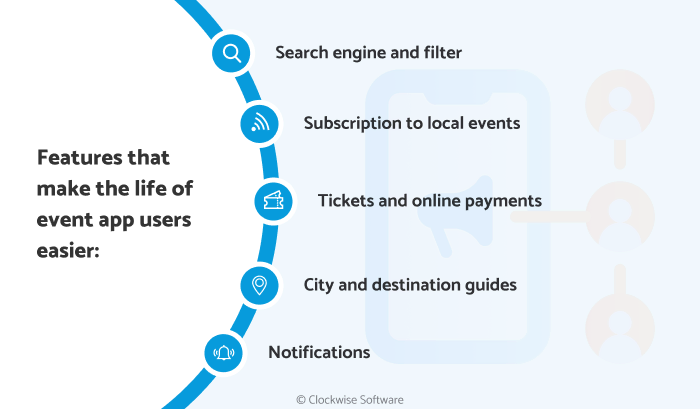
There is usually a team of people behind every event. They need to set everything up, take care of the venue, pull together necessary equipment, invite guests, and in all that fuss try not to forget who does what. So your app should become a bridge between the stuff that enhances communication and helps the team to track each other's activity.
This is what is happening behind the scenes. Next comes the part where event planners have to face their target audience. Their first meeting point is the event page. Develop a comprehensive step-by-step profile creation process to help organizers with this task. Offer ready-made templates and integrate design tools which will allow the team to customize their event page's appearance and let them add and edit the content anytime.
Provide event organizers with different channels through which they can reach their customers. These could include direct mailing via in-app chats, emails, personalized recommendations, push notifications, promo campaigns, and social media ads.
The next step is setting up a mobile box office to enable ticket purchasing. Here you can get your part of the cake by introducing a service fee that would be bearable for organizers, yet sufficient to keep your app up and running.
Monitoring attendee behavior before, during, and after the happening is a great way to improve both the event organization process and your app’s overall performance. By capturing user profile info and their interest data, you can form an accurate picture of each event-goer and thus cater to their requirements.
You can also add questionnaires, surveys, audience responses, and polls to help planners establish a connection with their attendees.
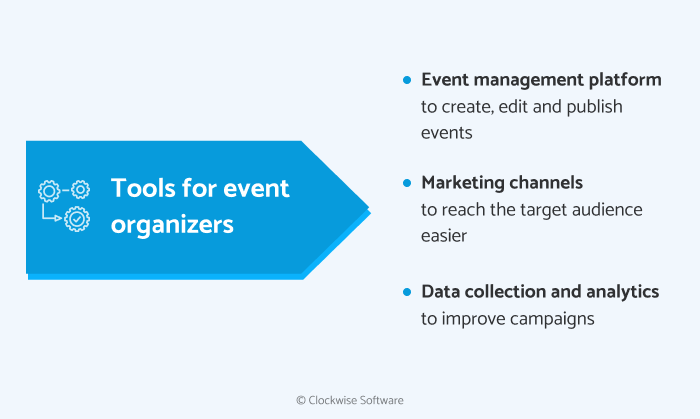
This is the business model used by most event aggregators. Normally organizers can list their meetings for free, and they only pay a small fee for every ticket sold. This could be a flat amount or percentage-based commission (sometimes a combination of both).
Take Eventbrite as an example. They use different approaches depending on the payout country. Organizers from Ireland and the Netherlands pay a fixed amount of €0.49 per ticket if its price is less than €10. In some countries like Argentina and Brazil, only percentage-based fees are applied, but most users pay both a percentage of a single ticket cost and a flat amount per each purchase.
The social event app is not only a place for planners and attendees to meet, but it is also a great opportunity for local enterprises to increase their visibility. You can use that to increase your revenue stream. One of the options is to place promotional banners on your app's homepage. You can also incorporate sponsored push notifications and lead a retrieval module.
Cooperate with other local businesses. This could take the form of special deals or bonus programs for your clients or some other practical arrangements. For example, you can establish a partnership with a taxi service and enable event-goers to get a cab home right on your platform. This way the fleet operator can attract new clients and you add value to your app while gaining extra profit.
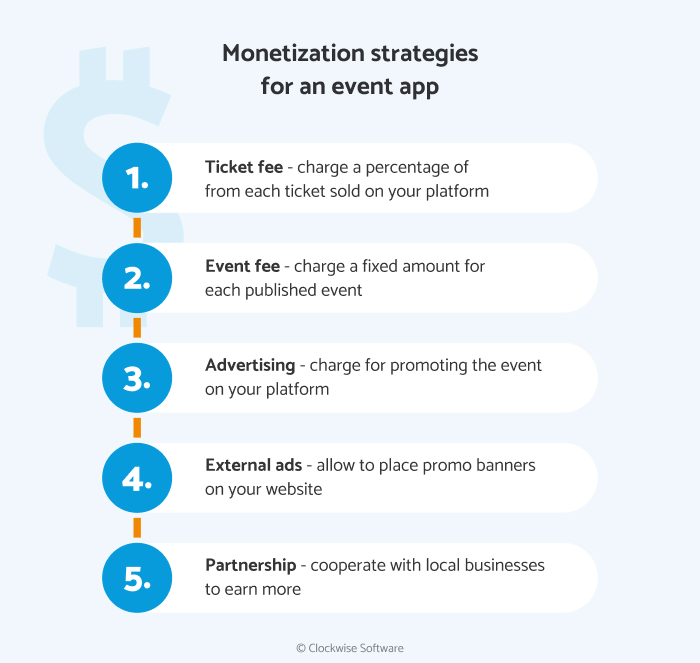
Even though the development process of the best app for local events might seem a Herculean challenge at first, you can manage it if you follow this step-by-step procedure:
If you want to build an event app like Eventbrite, you should figure out the peculiarities of the market you are about to enter. So the first thing on your to-do list would be research. Here are three main points you need to address if you are planning to launch such a local service:
Identify the most popular info sources about the upcoming happenings in your town/country
This will help you to figure out if there is a real demand for the solution you're going to offer.
Analyze other event-planning applications that are used in your area
Examine your competitors' strong sides, as well as their drawbacks. Turn the issues others failed to solve into an ace up your sleeve. This way you can secure a position one jump ahead of your rivals.
Get familiar with the needs of your target audience
Get feedback about what they find appealing in the apps they are currently using and things they don't like. Contact organizers and ask how they promote their products, what kind of event technologies they miss in their daily work, and whether they are willing to pay for such extended functionality. Check out what features event-goers are looking for. This will help you better understand how to make your service more attractive to them.
Sum up this information in a single document - this will help you to create your app business plan.
Your head can explode with ideas on how to create the best app for events, but you need to start with some peculiar features, which are known as 'minimum viable product'. MVP is the set of basic functions that are sufficient to attract early adopters. This step will help you to validate your product concept.
When it comes to a local event app, the core feature that will bring value to your customers is the ability to discover nearby happenings and activities that match their interests. So in this case, MVP would be the event feed with the general info about the meeting and organizer's contact details.

Once you've researched the market, spotted the problem your app is going to solve, and get familiar with the needs of your target audience, you can finally move on to the core of the development process — building an actual local event application.
Start with creating a wireframe to test out your ideas and see how your concept might look “in the flesh.” When you figure out which of those thoughts would actually be put into action, you can proceed with more elaborate features that will shape your app's UI/UX.
The hardest choice here is to decide whether you want to build a mobile or web-based solution. Mobile apps are compatible with specific operating systems and thus they offer the best overall performance and exceptional user experience. On the other hand, building a separate solution for each platform requires the extra cost to build a marketplace and regular updates. Meanwhile, web apps can be accessed from any device connected to the Internet, be it a laptop or a smartwatch.
Quality assurance is used to ensure that your app meets the set goals and expectations. It also helps to unveil its weak spots that demand further refinement.
Once all bugs are fixed and crushes tested, it's high time to see your app in action. Here comes the part where you deploy your application to the Google Play Store or Apple Store and make it available to the public.
Last but not least — let people know about your product.
In fact, the marketing process should start long before the app release and you should never cease to look for new ways to promote your product.
You can utilize various marketing channels: your company's website, word of mouth, social media, a demo video, blog posts on partner platforms, cooperation with tech influencers, Google Ads, app store optimization, etc.
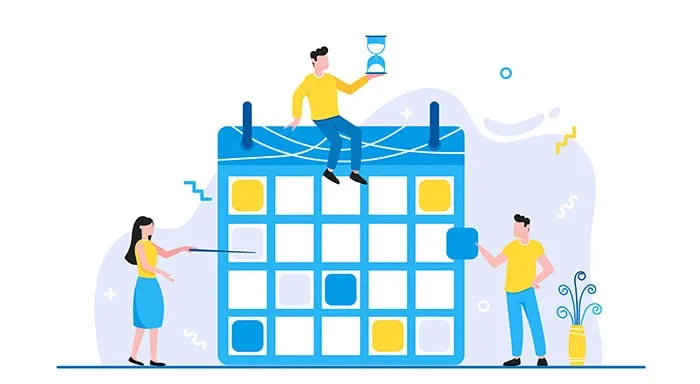
As your local event app is targeting two types of users, you should form your marketing strategy in a way to grab the attention of attendees and organizers as well. But what should come first? There are three main approaches to resolving this chicken-and-egg problem:
You should pay attention not just to your industry, but also gather ideas from other spheres. Follow the world-class brands and get inspired by their example. You can also check one of our studies, where we describe how to build and launch different types of apps:
How to Create an App like Wish and Make it Thrive?
How to Build Babysitting App Like Uber?
How to Create an Online Marketplace Like Etsy: An Extensive Guide
It would be hard to craft the best app for events without a committed group of tech specialists who share your vision. If you haven't decided yet whether you should hire an in-house team or outsource your app development — just check out this article, where we share the pros and cons of both approaches.
Once you meet your dream team, you can start bringing your ideas to life and build the platform that your fellow townsmen and local event planners have been looking for.
